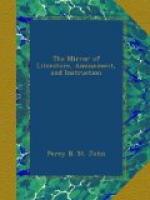At Rome are many minor fine arts practised, which are wholly unknown in England. The most remarkable of them is the Mosaic Manufactory, carried on at the cost of government: and its fruits are theirs. The workmen are constantly occupied in copying paintings for altarpieces, though the works of the first masters are fast mouldering away on the walls of forgotten churches. They will soon be lost forever; it is yet possible to render them imperishable by means of Mosaic copies; and why is it not done? The French, at Milan, set an example of this, by copying, in mosaic, the Last Supper of Leonardo da Vinci; but it was their plan to do much for Milan, and nothing for Rome; and the invaluable frescos of Michael Angelo, Raphael, Domenichino, and Guido, were left to perish.
It takes about seven or eight years to finish a mosaic copy of a painting of the ordinary historical size, two men being constantly employed. It generally costs from eight to ten thousand crowns, but the time and expense are of course regulated by the intricacy of the subject and quantity of work. Raphael’s Transfiguration, cost about 12,000 crowns, and the labour of nine years, ten men constantly working at it. The late works, are, however, of very inferior execution.
The slab upon which the mosaic is made, is generally of Travertine, (or Tiburtine) stones, connected together by iron cramps. Upon the surface of this a mastic or cementing paste, is gradually spread, as the progress of the work makes it wanted, which forms the adhesive ground, or bed, on which the mosaic is laid. This mastic is composed of fine lime from burnt marble, and finely powdered Travertine stone, mixed to the consistence of a paste, with strong linseed oil. Into this paste are stuck the smalts, of which the mosaic picture is formed. They are a mixed species of opaque vitrified glass, partaking of the mixed nature of stone and glass, and composed of a variety of minerals and materials, coloured for the most part, with different metallic oxydes. Of these no less than 1,700 different shades are in use; they are manufactured in Rome in the form of long, slender rods like wires, of different degrees of thickness, and are cut into pieces of the requisite sizes, from the smallest pin point to an inch. When the picture is completely finished, and the cement thoroughly dried, it is highly polished.
Mosaic, though an ancient art, is not merely a revived, but an improved one; for the Romans only used coloured marbles, or natural stones in its composition, which admitted of comparatively little variety; but the invention of smalts has given it a far wider range, and made the imitation of painting far closer. The mosaic work at Florence is totally different to this, being merely inlaying in pietre dure, or natural precious stones, of every variety, which forms beautiful, and very costly imitations of shells, flowers, figures, &c. but bears no similitude to painting.




